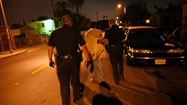Edward E. Sarnoff
A 4th grade teacher at Denker Avenue Elementary in 2010
These graphs show a teacher's "value-added" rating based on his or her students' progress on the California Standards Tests in math and English. The Times’ analysis used all valid student scores available for this teacher from the 2003-04 through 2009-10 academic years. The value-added scores reflect a teacher's effectiveness at raising standardized test scores and, as such, capture only one aspect of a teacher's work.


Math effectiveness


English effectiveness
About this rating
The red lines show The Times’ value-added estimates for this teacher. Sarnoff falls within the “average” category of district teachers in math and within the “less effective than average” category in English. These ratings were calculated based on test scores from 150 students.
Because this is a statistical measure, each score has a degree of uncertainty. The shading represents the range of values within which Sarnoff’s actual effectiveness score is most likely to fall. The score is most likely to be in the center of the shaded area, near the red line, and less likely in the lightly shaded area. Teachers with ratings based on a small number of student test scores will a have wider shaded range.
The beige area shows how the district's 11,500 elementary school teachers are distributed across the categories.
Sarnoff's LAUSD teaching history
Years used for value-added rating. See FAQ for details.
- Denker Avenue Elementary, 2010 - 2004
Edward Sarnoff's Response:

This value added model is flawed because the statistics do not accurately asses the value teachers add to student learning. In most cases, the California Standards Test for Language Arts is not an accuarate measure of student progress and should therefore not be used for teacher evaluation. Let me show you why. Imagine your a fourth grade teacher, with a group of 7 students on the second grade reading level. After a year of instruction, you manage to get them to the third grade level, a difficult accomplishment considering you teach a fourth grade curriculumn. Now, to accurately measure the progress, would you give them a second, third, or fourth grade reading assessment??? The state chooses to give a fourth grade assessment. What is the problem with this? This would be like giving kids who have just mastered their addition facts a multiplication test to see if they have improved in their addition. I am deeply disapointed in the integrety of the LA times as a credible news organization and I have to wonder if Eli Broad, the billionare who meddles in school board elections has paid off the Times to print these useless statistics. Remember, a teacher killed himself over this and your still at it again. Dishonorable!!
![]() The Times gave LAUSD elementary school teachers rated in this database the opportunity to preview their value-added evaluations and publicly respond. Some issues raised by teachers may be addressed in the FAQ. Teachers who have not commented may do so by contacting The Times.
The Times gave LAUSD elementary school teachers rated in this database the opportunity to preview their value-added evaluations and publicly respond. Some issues raised by teachers may be addressed in the FAQ. Teachers who have not commented may do so by contacting The Times.
|
|
 Delicious
Delicious
|
 Digg
Digg
|
 Facebook
Facebook
|
 Twitter
Twitter
|









